Energy of all kinds is on everyone's mind.
Nuclear energy, once the scourge of any right-thinking person who had lived through Three Mile Island and Chernobyl has not-so-suddenly become something Americans need to revisit if we are to tackle our energy problems in a holistic, modern, fashion.
The French and the Europeans and Eastern Europeans have had no such qualms. Not blessed by oil reserves, they have had to forge ahead with nuclear options and have been largely successful. Like their trains which are unsurpassed in efficiency, nuclear plants are all over France, near urban centers, yet you never hear the French talk about potential explosions unless they have to do with Nicolas Sarkozy's combustible love life.
And then there's the other use of an explosive atom.
When the periodic table is projected on the curtain at the outset of Doctor Atomic at the Metropolitan Opera House, you know we are going to get involved in how elements, chemical and human, can rub up against each other with toxic results. To the drone of an airplane, mug shots of the team of scientists who put together the A bomb in remote Los Alamos, New Mexico in the forties, are projected on small, Eames-style cubicles, an ant colony of genius mathematicians and physicists stacked one on top of the other (if you know Robert Longo's work, it is precisely that image). Flotsam and jetsam floats in front of what looks to be a series of white tents.

Doctor Atomic, with music by John Adams,spectacular production design by Julian Crouch (as in the Glass Satyagraha last season ), video design by 59 Productions, libretto by Peter Sellars (who was supposed to direct but had some kind of creative fallout with the Met -- the first fallout of the project) and directed by Penny Woolcock in her debut, is a haunting and sobering work. The opera was commissioned by San Francisco and has since been in Chicago and is a coproduction with the English National Opera.
Having visited Los Alamos and read the various J. Robert Oppenheimer biographies and letters (upon which this libretto is based), I was already intrigued by the notion that bomb makers could also pine for Baudelaire and speak six languages. A romantic who had socialist leanings made the first nuclear weapon, imagine that.
The idea that someone could sing about nuclear fission and make radioactive fallout compelling was not entirely surprising, and in some respects, especially those of the truly ingenious sets and video projections, the creators have succeeded beyond wildest imagination.

The music is relentless and serves its deadly subject well -- but I had to climb over it sometimes to stay in the emotional moment. This performance was conducted by Alan Gilbert, the NY Phil conductor-in-waiting, who contributed much warmth to the challenging score. The cast, especially, Gerald Finley, who created the role of Oppenheimer in San Francisco and Sasha Cooke who plays his wife and colleague, Kitty, acquit themselves admirably, even when they are having to give life to Sellars circumlocutions which are alternately Shakespearean (fain) and Sanskrit-y, even declaiming about the weather and caloric intake, though extra weight was not needed for a production already heavily laden with a bomb hanging over its head most of the time.
The closing moments of the detonation as the team watches with their sunglasses is probably the most incandescent way this chapter of our checkered nuclear history has ever been portrayed.

It's not the first time the creation of the bomb has been given a romantic veneer, all those smart people hanging out in the desert, able to think big thoughts. But Sellars makes sure the take away is of a Japanese mother searching for water and her children in voice over, a reminder of the eventual holocaust and toll on real lives and not just desert fauna.
The building of bombs, whether in Iran, Russia or the US is, alas, a topic that is still combustible. It is with a heavy heart that we leave the theater, knowing all too well that the incendiary concerns of Doctor Atomic are still very much with us.
